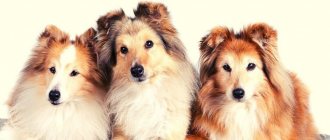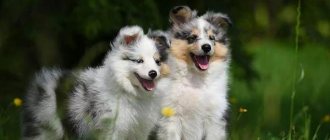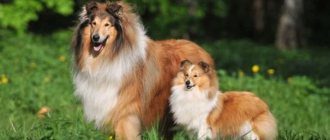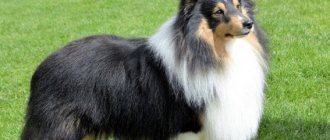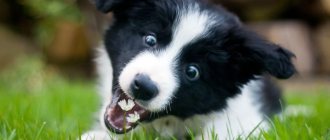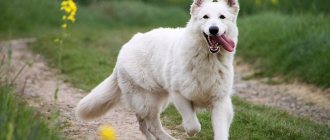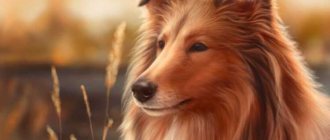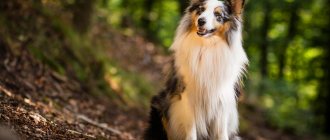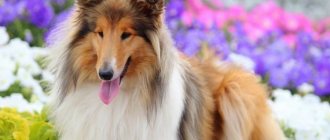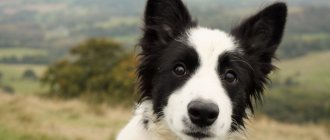Dogs of the Collie (Scottish Sheepdog) and Sheltie (Shetland Sheepdog) breeds are very similar in appearance, so they are often confused, mistaking the Sheltie for a mini copy of the Collie. Or, because Shelties are smaller in size, they are sometimes mistaken for Collie puppies.
Yes, indeed, there are breeds that have mini-varieties. They differ only in size. For example, Dachshunds and Mini Dachshunds, Maltese and Mini Maltese. But this in no way applies to Sheltie and Collie. These are two different independent breeds . They differ not only in size, but also in a number of other characteristics, which we will discuss in this article.
Description
It is easy for an inexperienced breeder to confuse a Sheltie and a Scottish Collie - these dogs are almost identical at first glance: both breeds have the same long hair, pointed muzzle and small erect ears.
This similarity between the breeds was the result of numerous breeding experiments to unify the breed qualities of the Sheltie. During these experiments, individuals of many other dog breeds were used, but the basis for the creation of the breed was the genetic material of Spitz and Scottish Collies. Unlike tall and stately collies, shelties are not so impressive in size.
As mentioned above, the first standard of this breed was formed back in 1914, after which it did not undergo significant changes.
- Average weight. These dogs are classified as miniature dog breeds - as a rule, they weigh no less than 5 and no more than 10 kilograms. Occasionally there are individuals of Sheltie with minor deviations from the norm, but this is not considered a strict violation of the standard.
- Average height. It's no surprise that some have labeled this dog breed as a "mini collie." If any variety of collie can reach a height of 70 centimeters at the withers, then the optimal height for dwarf shelties will be 35-37 centimeters (adult females and males, respectively). Regarding height, deviations of no more than 2.5 centimeters from the standard are allowed.
- Head and muzzle. Small elongated type, wedge-shaped. The muzzle tapers strongly towards the nose. The skull is flat, there is no pronounced bump on the back of the head. The stop is slightly expressed. The flat cheekbones of the muzzle are clearly visible.
- Nose. The lobe is small but well developed with large nostrils. The color is exclusively black.
- Teeth and oral cavity. The jaws are slender and elastic, well developed. Scissor bite. A special advantage in the exterior is considered to be an even dentition of 42 teeth.
- Ears. Not particularly large, spaced at a short distance from each other. In a calm state they are laid back, in a state of excitement they stand upright, the ears look forward.
- Eyes. The Sheltie's eyes are small, oval, and set slightly obliquely. The eyelids fit tightly to the eyeball and are black. Breeds with a dark color have a brown iris, while light-colored individuals (for example, merle color) may have a blue color with chocolate splashes.
- Neck. Not particularly long, but strong, covered with a layer of developed muscles. A slight bend is almost invisible under a thick layer of wool.
- Body. The back is straight, there is a beautiful bend in the lumbar region, the croup is strongly expressed, rounded. The chest is deep, but not particularly wide.
- Limbs and paws. The forelimbs are straight, set parallel, shoulders laid back. The hind legs also stand straight, the hips and knees are well defined due to developed muscles. The hock joint is set fairly low to provide greater primary speed. The Sheltie's paws are of medium size, collected in an oval ball. The fingers should fit snugly against each other.
- Movements. These dogs move quickly, but easily, gracefully and smoothly. Every step is like sliding on ice.
- Tail. The tail is medium-sized and covered with a thick layer of fur, also of medium length. Set on low, lowered when calm, the tip reaches the level of the hock joints. The structure of the Sheltie's tail is straight, without a curled tip. When excited, it is slightly raised, but does not rise above the level of the back. The tail tips of colored shelties are usually light or white in color.
- Wool. There are two levels: long and coarse guard hairs that retain moisture and cold; thick, dense and soft undercoat. When stroked, the wool springs slightly. The chest, back of the head and neck are covered with longer hair, forming a kind of “lion’s mane” that hides the ribs and elbows.
Reproduction and lifespan
Shelties are charming shepherd dogs with sociable inclinations and a good disposition. They are smart, loyal and sociable. Every breeder knows how to distinguish a purebred representative of the breed from an ordinary fluffy mongrel. There are a number of signs by which he can do this:
- The Shetland Sheepdog's coat should be shiny, long and rough to the touch.
- There must be a light mark on her sternum.
- The tail of such a dog should be low and hang down evenly, and not lie on the back in a “ring”.
- There are 42 teeth in her mouth.
- There are no dewclaws on the front paws.
When a Sheltie bitch is in heat, the breeder should monitor her mood and well-being. He must wait until the 4th day of her menstruation and then go with her to the male dog's house. He will definitely sniff the female, after which he will demonstrate to her his interest in mating.
She, in turn, can accept his advances, or push him away. In the second case, their meeting will have to be rescheduled for another day. Life expectancy with proper and timely care is from 14 to 16 years.
Training and education
There shouldn't be any problems with collie socialization. This breed is perfect for novice dog owners. She is smart and obedient, so she is easy to train. All household members can raise their four-legged friend.
The animal must understand that, despite the affection of all family members for it, it cannot live with it on equal terms. What does this mean? Rules must be established between man and dog. Their absence may result in the dog becoming uncontrollable.
A collie living in an atmosphere of permissiveness will become a big problem for the family. He is a large and active dog, which, if not obedient, can knock dishes off the table, damage objects, and jump on people who come into the house.
To prevent this from happening, you should take up educational work from the first days of his stay in the house. So, let's look at a few basic rules for dog socialization:
- She must know her nickname and come to the person at the first call. To do this, repeat the puppy's name several times a day. That way he will remember it.
- The dog should not beg for food while the family is at the dinner table. If he approaches, you should show him his place.
- “Go to your place” is one of the basic commands that your pet dog should know. If you want to remove her from the room, you just need to say this phrase.
- Anyone can teach a collie to give a paw or lie down. This is a very intelligent breed, characterized by excellent trainability. We recommend using cheese or food as a reward.
- You should not allow a large fluffy dog to climb onto your furniture, as, firstly, it will spoil him, and secondly, he will leave his fur there, making cleaning difficult.
- Collie can't stand being alone, but sometimes he has to stay home alone. It is recommended to accustom him to this from childhood. You should not feel sorry for the dog if he anticipates separation from his household and begins to whine. Give him the opportunity to cope with stress on his own. When leaving, say: “Wait.” Subsequently, the animal will begin to associate this word with the arrival of a person and will cease to be afraid of the upcoming separation.
Some collies become so attached to people that they become psychologically dependent on them. They strive to constantly be nearby, to take care of their household members. At first glance, this seems cute, however, such an animal’s attitude towards people is pathological.
There are many known cases of starvation of dogs that could not stand separation from their owner. This is not the norm. Therefore, there must be rules regarding a person and his four-legged pet
It is important that the dog sees you as a leader. Only in this case will she trust and listen
Never demonstrate your authority to her with physical force. The domestic collie will not tolerate beatings. To lose a dog’s trust forever, it is enough to raise your hand to it once.
The classic method of proving your primacy to an animal is to be present during its meal. Fill your collie's bowl and invite him to it. Do not take your hand away from the dish so that the animal understands that you have a similar claim on the food you presented to it.
If you hear a dog growl, do not scold him. This reaction is natural. Try to treat the animal with something more tasty, for example, a piece of meat. This way he will be able to associate you not with a threat, but with a tasty treat. To rid your collie of stubbornness, you need to play sports with him. He needs exercise to maintain health and good shape.
If there is an opportunity to introduce a young shepherd dog to another dog, be sure to take it. Experts say that a person’s pets should communicate with their own kind. This will allow them not to lose social skills and adapt well to any conditions.
You should not go out with your collie into an area where he might be interested in a pack of stray dogs. It is better to choose open, clean clearings for a walk, where you can run or play catch.
When training a collie, you need to be patient. Sometimes these dogs become stubborn and withdraw into themselves. In this case, they should not be punished, but interested. Motivate your dog to train with treats or massage.
Health
Like any other breed of dog, Sheltie is prone to certain diseases:
- dysplasia of the hip and elbow joints,
- hypothyroidism,
- eye diseases,
- epilepsy.
Preventive measures to protect your Sheltie puppy
- To keep your Sheltie puppy completely safe, you first need to minimize his contact with unfamiliar dogs, especially strays. Therefore, you should not let your dog off the leash, as in this case it will become impossible to control its behavior and communication with other dogs. Since a dog can easily become infected with distemper from simply touching the nose of a sick animal. This disease can be transmitted to a dog through sniffing. Your dog can become infected with trichophytosis from contact with the lichen-affected fur of a sick dog. Naturally, it is impossible to completely exclude a dog’s communication with other dogs, since it must be socialized. Therefore, try to find friends with dog lovers who look after their animals. By adhering to this rule, you can eliminate the risk of pathogen transmission by 80%.
- You should walk your dog in places where there are no landfills. Since garbage very often attracts rodents, which in turn are very often carriers of various infections. Gray rats are especially dangerous because they carry such a serious disease as leptospirosis.
- You should not allow your dog to sniff other people's feces, as they are a source of worms.
- Monitor your Sheltie's well-being. Pay attention to even the most minor changes in his behavior. For example, your dog may appear lethargic, lose his appetite, or have a dry nose. Or you may notice that the dog begins to shed, and this has nothing to do with seasonal shedding. If hair loss becomes excessive, this is the first symptom indicating health problems in your pet. And only you can help him. Therefore, it is important to take the dog to the veterinary clinic in time, where the disease can be overcome for sure. In no case should you ignore the symptoms, since advanced infections are much more difficult to treat, and sometimes even impossible. If you start treating your dog, the disease can lead to his death or he will develop serious complications that will affect his hearing, vision, limbs and much more.
Nurseries
There are many Sheltie breeders in Russia. For example, in the city of Kemerovo there is a nursery “Shelmert”. You can also find collie puppies there. In Moscow there is a kennel “Russian Versailles”, which breeds shelties, miniature pinschers and other dogs.
Note! If you wish, you can buy a puppy in another country, but it will be much more expensive. The price includes not only the price of the baby, but also its delivery.
But in this way you can get a baby of a rare color or from very famous parents.
The Sheltie is not a miniature collie, but such a dog still requires attention and care. She does not tolerate loneliness well and loves to spend time with her owner. She needs to be brushed every day and taken to the groomer from time to time. In return, a person receives a devoted pet who is very active and cheerful. Shelties have a long life expectancy, so you need to think twice before purchasing a puppy.
*Prices are as of November 2022.
Puppies
It is difficult to confuse a mini collie puppy with another dog. Dogs' ears stand up early, their fur grows quickly, and their color does not change over time. Therefore, you can take the baby from the mother at 2-2.5 months - after the first complementary feeding and a course of vaccinations.
Note! If a baby of this breed is bought to participate in exhibitions, then it is better to wait until 5-7 months to see all the features of the exterior. Sports dogs are bought as early as possible; external qualities are not important for them, but they need good training from a young age.
Education and training
Intelligent, efficient and incredibly inquisitive, collies are among the top easiest to train breeds. However, it is possible to achieve positive and quick results only if there is a friendly attitude. Remember, the Scottish Shepherd has a vulnerable psyche and categorically does not accept an authoritarian style of communication. Moreover, the home atmosphere plays a huge role for her. If the family communicates in a raised voice, it is stressful for the pet, which prevents it from delving into the educational process and turns the puppy into a stupid, nervous creature.
Don't be afraid that your shaggy friend will misinterpret your loyalty during the training and begin to pretend to be the “big boss”. The breed is not prone to dominance in principle and prefers kind mentoring from the owner. Otherwise, Scottish Shepherds are raised according to the same pattern as most breeds. First - socialization and establishing contacts with family members, then - getting used to the daily routine, then - getting to know the street, new smells and sounds.
At all of these stages, you can and should introduce the puppy to basic commands. At 2 months, the four-legged prankster is taught to respond to the call “Come to me!” and understand the order “Place!” At 3 months, the pet is introduced to the leash and the commands “Walk!”, “Sit!” 4 months is the optimal age to learn the orders “Near!”, “Ugh!” and “Lie down!” Well, a six-month-old teenager is able to master more complex actions, for example, fetching on command and the requirement to “Stop!” By the way, about fetching: collies are one of the few breeds with a reduced tendency to chew objects, so any toys these shepherds have last longer.
It is better to work with the “Scot” on the street, and first you should take the puppy for a walk, and then get down to business. During the first lessons, your pet will be distracted by external stimuli, and this is normal.
Gradually, the animal will learn to control its own attention and concentrate on human demands. The main thing is not to overdo it with repetitions of commands and duration of classes.
The time interval during which a Scottish Longhaired Sheepdog is able to maintain attention on one action is 5-10 minutes.
As for training programs, the breed copes perfectly with UGS and OKD. The international standard for obedience (obedience) also passes the majority of individuals. Theoretically, nothing prevents the owner from walking with a collie and a ZKS, but this is done more often “for show” - the character of Scottish Shepherds lacks healthy aggression and suspicion, so necessary for a bodyguard dog.
What is the difference between intelligence
Both of these breeds are highly intelligent dogs. They are easy to train and can learn many commands without being stubborn.
Both of these breeds are emotionally very attached to their owners and try to please them, anticipating their desires . It is not difficult for them to adapt to the lifestyle of their owner. Both Collie and Sheltie are great with children, acting as a nanny. They generally have no desire to dominate. They do not strive to show “who’s boss.” However, these intellectuals of the dog world, if necessary, are able to act independently, choosing the right decision.
Numerous reviews from owners indicate that the Collie is a much more self-sufficient dog than the Sheltie.
Character and training
Turning to the primary description of the breed, which was assigned to the ancestors of the Sheltie, you can be seriously scared. The four-legged animals were ferocious, especially when it came to sharing food. The modern characteristics of the breed contrast greatly with history; the Sheltie is a brave, active, loyal, intelligent, vigilant, conscientious and responsible dog, distrustful of strangers. Aggression, especially towards people, is recognized as a serious vice!
The devoted and amorous character of the Sheltie also gives rise to the main disadvantages of the breed - the four-legged dog cannot be left alone for a long time. Temporary living with relatives (during vacation) will be torture for the four-legged one. If you decide to buy a Sheltie puppy, think through in advance all the nuances associated with departures, business trips, etc.
The characteristics of the breed also reinforce its advantages. Shelties are very loyal and responsible, literally. Already at 3-4 months of age, puppies show unexpected sociality, very rarely chew things and quickly get used to going to the toilet outside.
The Sheltie is suitable for single owners and large families. An older dog turns into the most responsible and gentle nanny if there are children living in the house. Cats, birds, hamsters and other neighbors are perceived as friends and associates. By the way, many owners acquire 2-3 Sheltie puppies at once and such a “flock” coexists in peace and harmony, even if it contains same-sex dogs.
Sheltie training is a pleasure for experienced dog owners and a challenge for beginners. Even a teenager can raise a dog, since four-legged animals literally read the owner’s thoughts. Four-legged dogs do an excellent job with general training, tricks and all types of dog sports.
Breed traits
Breed traits (on a 5-point scale)
| Sheltie (Shetland Sheepdog) | |||
| Activity | in the house | 3.1 | |
| on the street | 3.8 | ||
| Obedience | training | 4.7 | |
| strangers | 4.6 | ||
| Domination | in family | 1.5 | |
| over dogs | 2.1 | ||
| Defending your territory | from people | 2.1 | |
| from dogs | 2.5 | ||
| Sociability | in family | 4.7 | |
| with strangers | 2.8 | ||
| with dogs | 2.9 | ||
| Concentration | in family | 1.4 | |
| in front of strangers | 3 | ||
| with dogs | 2.4 | ||
| Aggressiveness | in family | 1.2 | |
| to strangers | 1.8 | ||
| to the dogs | 1.9 | ||
| to cats | 1.9 | ||
| Family behavior | calmness | 4.7 | |
| demand for affection | 4.3 | ||
| excitability | 3.9 | ||
| playfulness | 4.3 | ||
| excessive barking | 3.5 | ||
| behavioral breakdowns | 1.9 | ||
| Tolerance for children | up to 4 years | 3.5 | |
| over 4 years old | 4 | ||
| Institutional use | watchman | 4.3 | |
| bodyguard | 1.9 | ||
This breed is often compared to the following dog breeds: Border Collie, Longhaired Collie, Australian Shepherd (Aussie), Pembroke Welsh Corgi, Schipperke.
The photo shows what a Sheltie looks like:
Conditions of detention
Training and raising a pet
Sheltie training begins at a young puppy age. From 2 to 3 months, it is necessary to begin by socializing the pet, and then begin training. After all vaccinations have been completed and the puppy has been activated, accustom him to a leash and collar. Go outside at least 3-4 times a day, for short walks.
Go out into crowded places and let them interact with strangers and animals. The faster the puppy gets used to loud noises (cars, people), the better.
Training should be short, 15 minutes, with the study of the simplest commands, increasing the load and time as the puppy grows up. Be sure to remember about encouragement; goodies in the form of cheese and crackers are suitable.
When training, show restraint, exactingness and perseverance, but without the use of physical force and shouting. If you do not have enough experience or feel that you cannot cope with a puppy, contact a specialist, and then continue on your own.
Care and maintenance
The characteristics of the Sheltie dog suggest that the main care will be on the animal's fur, it is not surprising that the owners of such a luxurious fur coat, of course, require special care.
- Caring for a mini Sheltie is not that complicated, but it’s not particularly easy either, because it requires regularity.
- Wool: treatment against wool parasites, should be done regularly. You will need to comb it at least 4 times a week, during the molting period 2 times a day using a special comb brush. You will need to purchase: a medium-length massage brush, a slicker brush, metal brushes with rare and frequent teeth. If tangles have formed, do not write off saying goodbye to them, moisten them with water or a special balm and sort them out with your hands, then comb them with a fine-toothed brush.
- Bathing: when dirty and only with dog shampoos, use conditioner. Before exhibitions, you can moisturize with a special spray and dry with a hairdryer, in the direction of hair growth. The water should not be too hot. Suitable for every day, simple paw leakage after a walk, the coat can also be wiped with a damp cloth.
- Nails: trim at least 1-2 times a month with a nail clipper. You will need to accustom your pet to this procedure from a young age.
- Ears: remove excess wax with a cotton swab dipped in a special lotion. 1-2 times a month.
- Eyes: remove excess secretions regularly, check for any foreign odor or color. It is better to do this at least 3 times a week.
- Vaccinations: Regular vaccinations and immunizations. Treatment for parasites. Remedy for worms.
- Teeth: brush your teeth yourself with a brush and give them a bone-cleaner to remove plaque. An unpleasant odor from the mouth indicates problems with the gastrointestinal tract or teeth.
- Doctors: regular examination by a veterinarian at least 2 times a year.
Feeding and diet
The best option for them is dry food. It has already been selected for each breed and is balanced in composition, which is difficult to do when feeding natural products. Does not require additional vitamin and mineral complexes.
Adults eat 2 meals a day, puppies eat small portions 4 - 5 times a day. Provide constant access to water. Premium food is preferred.
Products for natural feeding:
- Meat (not fatty);
- Sea fish;
- Dairy products;
- Porridges and cereals;
- Vegetables and fruits, berries;
- Vegetable fats;
- By-products;
- Dried fruits;
- Eggs (rarely and only raw);
Exclude: potatoes, tubular bones, sweets, bread, pasta, table food.
From proper nutrition, envy quality of life, health and duration. The more balanced the diet, the better for the pet. If in doubt, consult your veterinarian.
Login to the site
Those who are planning to get a dog have a lot of questions related to the character, behavior and maintenance of animals. In this article I will try to answer some of them. Is a Sheltie a smaller version of a Collie? - No. Of course, dogs of these breeds are similar to each other, but no more than cousins. Collie and Sheltie are completely different breeds that differ both in appearance and behavioral characteristics. Externally, the Sheltie differs from the Collie not only in size, but also in the structure of the head - the size and position of the ears and eyes. There are differences in the exterior of the body and limbs, and importantly, the Sheltie standard allows for a greater variety of colors than the Collie. As for the behavioral characteristics of Collie and Sheltie, there are also significant differences in this. The character of most collie dogs can be illustrated by a phrase from a poem - “...a canine aristocrat is a collie.” Collie demonstrates with all its behavior that it is a royal dog, full of its own dignity. Collie is friendly to people and other animals, unobtrusive. The character of the Sheltie, like most medium-sized dogs, is very cheerful. If you have a Sheltie, then its long nose will definitely find its way into every crevice of your home. These dogs are often very talkative. In general, if you lead an active lifestyle, then the Sheltie is your dog. Is it true that dogs of these breeds are good nannies? Partly, true. I think that people drew this conclusion from the general behavioral characteristics of dogs of these breeds. Collies and Shelties are very good-natured and patient. Such a dog will not allow itself to bite, or even growl or show its teeth in response to not always kind children's games. Owners of dogs of these breeds will tell you a lot of stories about how well their dogs and children communicate. When my daughter was born, my first collie dog, Vilda, was already 8 years old. I was a little worried about how the dog would react to the appearance of a little man in the family. But it was all in vain. When Katyusha woke up at night and began to groan and toss and turn in her crib, Dunechka (that’s what we called Vilda at home) came up to me and started poking me with her wet nose, as if saying: “Wake up! How long can you sleep!” But, in any case, you should not humanize dogs, and their communication with children should be under the supervision of adults. Collies and Shelties are so naturally intelligent that they do not require any training . No, this is one of the deepest misconceptions! Any dog, any breed, any size and any personality needs socialization and training. Firstly, attending club courses will bring you together, teach the dog to understand a person, and the owner to understand his pet. Secondly, no matter how smart a dog is by nature, all its tricks are initially aimed at how to achieve what it wants, and not how, in your opinion, the dog should behave. Remember, “smart” and “well-mannered,” as they say in Odessa, are two big differences. Collies and Shelties have long, thick coats that require a lot of grooming. I cannot agree with this thesis. If your dog has the correct coat structure, then it does not require special care. It is enough to comb the dog well once a week and wash it as needed. Of course, during the molting period this will require additional effort, but owners of almost all dogs, not just long-haired breeds, face this. But what magnificent warm products the collists knit from the wool of their pets! Of course, there are a lot of questions that future dog owners ask. Here are those without which, as a rule, no conversation about my dogs is complete. All theses of this article are supported by photographs from the life of our breeding plant; everything that is written here is my personal experience of communicating with beautiful dogs of the Collie and Sheltie breeds. I tried to tell you how beautiful these animals are.
Characteristic
The Sheltie can be recommended to both experienced and novice dog lovers. She is easy to train, good-natured, but wary of strangers. Requires physical activity, but not as much as many other breeds (hunting, for example). An hour in the morning and evening is enough.
In the past, fluffy shepherds guarded chicken coops and also tended herds of goats and sheep. Their task was to guide the animals towards the house and make sure that no one got lost. Being in the field for several days, Shelties were able to catch a bird or small animal for dinner. When breeders began to breed larger sheep, larger dogs were also needed. The breed almost disappeared, but enthusiasts saved it. Today it is a working dog of small size and very beautiful.
- May howl and whine when left alone. This character trait requires adjustment at a young age.
- Does not tolerate rudeness and force, and can become stubborn and aggressive.
- Not suitable for the role of a guard, but will always bark to warn of the arrival of a stranger.
- Well suited for agility training.
Pros and cons of the breed
| + | – |
| A wonderful companion | Needs constant attention |
| Suitable for living in an apartment with frequent walks | May be cowardly due to natural timidity |
| Good with children | Sheds profusely |
| Compatible with cats and other animals | Wool requires careful care |
| Easily trainable | Prone to barking for no reason |
| Successful in agility | Not suitable for homebodies |
| Not prone to dominant behavior |
The Sheltie is an ideal pet. She adores all family members and willingly plays with children. The dog needs constant activity. If left alone, she will find destructive entertainment. This breed needs the approval of its owners. Feeling useless will cause moral injury.
Sheltie care
The small size of the dog simplifies both maintenance and care. Combing is a mandatory procedure. If the owners are lazy, the fur will become matted, and then it will be very difficult to comb it. According to reviews, caring for the coat is not as difficult as it might seem; brushing it a couple of times a week is enough. During molting, this must be done more often.
The owner also has to bathe the Sheltie, which she loves very much. Shampoo must be used once a month; more frequent use upsets the balance of the skin, which affects the appearance of the pet. It is necessary to examine the eyes and ears daily and clean them as necessary. Teeth brushing is mandatory. Once every six months you need to show your pet to a veterinarian.
Sheltie dogs
The Sheltie's amazing intelligence makes her a wonderful pet. This breed is suitable for both single people and large families. Given adequate exercise, the pet will become a good friend who is fun to live with.
A very clean and easy-going breed. Smart - masters commands on the fly, has a very lively mind. The only drawback is that he whines a lot, howls, and begs at the table. He communicates well with children and loves to play. Feels good in a city apartment. Shows very well at shows and treats its offspring with care. Recommend for families with children.
Anna
My mother took a puppy, she wanted it to be small and obedient. We decided to buy a Sheltie and did not regret it. From the very beginning, the puppy began to wear a diaper, did not howl at night, and does not even climb on furniture. He got along well with the cat, but he likes to climb into his litter box and scatters all the contents around the apartment. True, the breeder assures that this is a temporary phenomenon and the dog will outgrow it. Overall, very satisfied.
Eugene
The breed is well suited for city dwellers because of its small size. True, it is necessary to carefully care for the coat. She is very willing to train, even a child can teach her simple commands. An obedient and unobtrusive breed that understands its owner at a glance. An excellent family dog that will become everyone's favorite.
Julia
Common diseases
Thanks to their strong immunity and great mobility, Shelties rarely get sick. However, sometimes you still have to visit veterinarians.
The first signs of disease in nimble representatives of the breed are immediately noticeable: Sleeps for a long time and eats poorly. See a doctor immediately if the dog is not frolicking and is not interested in its surroundings.
What diseases is this breed susceptible to?
- Eye diseases - cataracts, corneal dystrophy. After being examined by an ophthalmologist, if diagnosed early, the dog will recover. If a retinal detachment occurs, the dog may go blind.
- Hearing problems are rare, unless it is a congenital disorder.
- Skin diseases. Due to skin sensitivity, dermatitis and dermatomyositis may occur. Even a small wound that is not treated promptly can cause a serious illness.
- Joints. The problem with this breed is rapid wear of joints and dislocations. Often this can only be corrected with surgery. Be careful when walking, there are no genetic problems, and the dog will not suffer from joint pain.
Vaccinations and visits to the veterinarian will protect your miniature pet from disease.
Sheltie - price and how to buy correctly
The price of a Sheltie dog will depend on several factors:
- City;
- Place of purchase;
- Puppy class;
- Coat color;
- Floor.
Dogs with bicolor and bimel colors are more expensive. Sable coloring is common in this breed, so such puppies will cost the buyer less. A puppy without defects will cost about thirty-five thousand rubles. A dog from famous parents can be more expensive. If the puppy has a minor defect, then its cost will not exceed fifteen thousand rubles.
Choosing a Sheltie puppy is a difficult task. These dogs are susceptible to many diseases, so you need to recognize a sick baby right away. The risk of purchasing a sick puppy will be much higher if you make your purchase secondhand, based on an ad on the Internet. It is better to take such dogs to specialized nurseries, where they are bred by real professionals.
The puppy must be selected in person, and not based on photographs. You need to go to the nursery and fully examine the possible options. You need to make your choice among cheerful, fluffy and well-fed babies. A healthy puppy will have clean ears and eyes. The area under the tail should also be clean - without signs of diarrhea. The puppy's coat should smell pleasant and be soft to the touch. If your baby itches, it means he has fleas.
You should pay attention to the behavior of your Sheltie puppy. A dog that is too lethargic or, conversely, too active may have a defect
Lameness, unsteady gait, apathy, thinness - all these are alarming signs. It's not worth adopting such a puppy
It is also important to determine the gender of the baby. Bitches are more expensive than males, but are significantly inferior to them in terms of visual attractiveness
Sheltie boys are much brighter and more interesting.
Preparing a Sheltie Home
Puppies of this breed are even too active . To protect them from troubles and keep the house in order, you need to follow a number of rules:
- all surfaces should not be slippery,
- It is necessary to remove small objects, wires, jewelry, valuables, expensive shoes from a visible place,
- you need a lot of toys, you can buy them at a pet store, or you can create them from available materials in a round shape,
- dogs love communication and are more quickly tamed to the house; they will feel free if there are small children or other pets in it.
Origin story
There is no reliable information about when and by whom the first Sheltie dogs were bred. But among dog handlers, the two most plausible versions are in circulation:
In addition, experts suggest that the Sheltie gene pool was formed with the participation of King Charles Spaniels and other continental breeds. The time frame for the formation of the species is outlined by the 9th–14th centuries.
The main purpose of the dogs was shepherding service. The small, but nimble Scottish Sheepdog Sheltie skillfully coped with the rutting sheep, deftly urging animals that lagged behind the flock. However, in the 19th century, British breeders developed new, larger varieties of livestock. The intelligent, but almost dwarf Sheltie dog could do little to oppose the massive sheep, except for a ringing bark and light biting. As a result, the herd did not listen and wandered randomly.
Miniature dogs were replaced by large types of shepherd dogs, and the Sheltie breed fell out of favor. The population was rapidly thinning, almost on the verge of extinction. Local enthusiasts, led by experienced breeder James Loggie, decided to save the Shetland dogs. By that time, Shelties began to be kept as ordinary pets, and it was decided to make excellent home companions out of the former shepherds. To do this, they tried to standardize the species of individuals, endowing the offspring with selected genes.
They wanted to call the revived breed Shetland Collies, but Scottish Collie breeders opposed this decision.
Due to the similarity of names, there could be confusion in the breeds, so we had to take the indignation of our colleagues into account. Based on its main habitat and in honor of its original purpose, the updated species was named Shetland Sheepdog or Sheltie for short.
The population began to grow, which was facilitated by the creation of the Scottish and English Sheltie clubs (1909 and 1914). Around the same time, several representatives of the breed were exported overseas, and in America, mini collies instantly won the sympathy of the public. And after another couple of decades, the breed achieves the honor of being officially recognized. In 1948, the English Club created a standard description of the breed for Sheltie, which would later be used as a basis by other cynological federations.
Interesting Facts
Interesting facts about this breed will help you get to know the Sheltie better:
- The popularity of mini collies has played a cruel joke on the quality of the breed lines. Unscrupulous breeders use all individuals for breeding, regardless of the quality of fur, compliance with standards and health status.
- Little collies are one of the smartest animals in the world. Canadian psychologist Stanley Corren found that dwarf collies recognize not only human gestures and voices, but also facial expressions.
- Due to the development of their intelligence, these dogs are too stubborn and require specialized training.
- Shelties bark frequently and loudly. Moreover, they make a whole range of sounds, each of which carries an information load.
Diseases and health problems
The dog's body is characterized by good immunity and good health. Four-legged animals can easily endure a two-hour walk in cold weather.
Despite this, there are a number of diseases to which the breed is prone:
- Dermatomyoside is a skin disease that causes muscle problems. According to researchers, about 70% of individuals are susceptible to this disease;
- Mental disorders, epilepsy - convulsions with salivation, involuntary bowel movements;
- Nasal solar dermatitis is peeling of the skin of the nose, sometimes its color changes. If not treated promptly, the disease can develop into cancer. Deterioration of the condition will be prevented by limiting exposure to sunlight, using sunscreen, and tattooing with black ink;
- Dysplasia - problems with joints;
- Deafness - individuals with marbled color are susceptible to the disease;
- Collie Eye Syndrome is a disease that develops into blindness. Leads to retinal atrophy, cataracts, and choroidal hypoplasia.
The brains of herding dogs may undergo changes in the cerebellum. Brain damage is difficult to treat and leads to neurological disorders. Occasionally, allergic reactions to dry food or certain products occur due to individual intolerance.
The average life expectancy of a pet directly depends on the living conditions, quality of food, and duration of walks. The absence of congenital diseases shifts all responsibility for the dog’s immunity to its owner. With proper care, the dog will feel good and have good health.
Feeding dogs
As with collies, shelties do not have problems with nutrition. Depending on the activity of your pet, you need to exercise some caution: puppies require a full 5-time feeding. The menu should include meat , dairy foods, vegetables and porridge.
- Any meat is suitable except pork. Regular consumption of this species with low pet activity can lead to obesity. Any product must be seedless.
- A variety of dairy foods is given; it is also advisable to prepare different types of porridge; you can mix them together.
- Vegetables are served only raw and finely chopped.
- Shelties are distinguished by their love of sweets. Dogs should be pampered with fruits and berries containing sugar.
Important! Any food is served on a stand, which should be at the height of the pet. The development of the dog’s skeleton and posture directly depend on this. It is best to purchase an adjustable stand.
An adult Sheltie is not picky about food, however, his diet should contain all the variety of necessary products. Many owners prefer to feed their pets dry food. This is normal and will not harm the animal . Only with such feeding should you monitor the health of your teeth and the constant availability of fresh water.
Sheltie and collie will become faithful companions for life to the one who makes his choice. With the right approach to training, these dogs will become irreplaceable members of the family, and even a novice dog breeder can master their training.
Appearance of the Shetland Sheepdog
Sheltie puppy
At first glance, the Sheltie is a light version of the Scottish Collie. The animals have the same long silky fur, a pointed muzzle and a penetrating gaze. Shelties owe their similarity to this “legend” of British cynology to the experiments of breeders who, in an attempt to stabilize the breed qualities of shepherd dogs, actively bred them with long-haired collies.
As for the modest size of dogs, they can be regarded as the result of adaptation to their environment. The ancestors of the Shetland Sheepdogs who lived on the archipelago were not spoiled with hearty food, and the weather conditions in the north of Britain leave much to be desired. The average weight of an adult Sheltie is 5-10 kg. Often animals do not fit into the given limits, gaining several extra pounds, which the breeding commissions turn a blind eye to. At the same time, the height of the animal is a constant value and fixed by the standard: for females - 35.5 cm, for males - 37 cm. Deviation in any direction by more than 2.5 cm is considered a defect and automatically excludes the dog from the “show caste”.
Head
The Sheltie's head is graceful, proportional, in the shape of a blunt wedge, tapering towards the nose. The skull is flat, without a pronounced occipital protuberance. The lines of the forehead and muzzle are parallel to each other. There is a small stop. The cheekbones are flat near the muzzle and slightly rounded near the skull.
Sheltie in profile
The earlobe is small, black.
Teeth and jaws
Sheltie's jaws are smooth and developed. Bite – deep “scissors”. It is desirable to have a full set of healthy teeth (42).
Ears
The Sheltie's small ears are located close to each other. In a calm animal, the legs are folded and laid back. An alert shepherd's ears are raised and point forward, while the tip of the ear flap remains lowered.
Eyes
The middle ones are almond-shaped and set slightly obliquely. The skin of the eyelids is black. The shade of the iris is dark brown; in marble-colored individuals it is blue or brown with blue speckles. The look is attentive, inquisitive.
Body
Straight back with a graceful curve in the lumbar region and a rounded croup. The chest is deep, with well arched and tapering ribs.
Sheltie muzzle
The Sheltie's front legs are level, with the shoulders laid back and equal in length to the shoulder blades. The pasterns are strong, the shoulder angles are quite pronounced. The hind legs are straight, with muscular, massive thighs. The hocks are set low and well angled. Paws are oval-shaped with arched toes tightly adjacent to each other. The movements are smooth, flying.
Tail
Sheltie merle color
With long hair, set low and reaching to the hock. The Sheltie's tail is not curled; in a moving dog it may rise slightly, but not above the line of the back. The tip has a slightly curved line.
Wool
The Sheltie has a double-type coat: with coarse and long topcoat and a soft, dense undercoat. In the neck area, the outer hair forms a lush mane; the animal’s hips are hidden by wide “pants.” There are long “feathers” on the back of the forelimbs.
Color
The breed standard defines the following types of Shetland Sheepdog colors:
- sable – dark and light options;
- tricolor/tricolor – black body with brownish-reddish tan markings;
- blue merle - silver-blue background with light black specks (marble color);
- black and white - with white markings on the forehead, neck, tip of the tail, chest and legs;
- black and brown – with or without white markings.
Undesirable: wolf and gray colors, asphalt and rust shades, as well as the presence of white spots on the body of bicolor animals and large black markings on the coat of marbled individuals.
Defects and vices of the breed
Sheltie at the show
Any deviation from the breed standard is regarded as a defect. For example, in order to be blacklisted by the breeding commission, a Sheltie only needs to have light eyes (with the exception of merle-colored individuals), erect or floppy ears, and an abnormal bite. Serious defects that spoil the appearance of the breed are:
- clubfoot;
- short, curly or wavy coat;
- lack of pronounced undercoat;
- tail that is too short or curled;
- incomplete set of teeth;
- convex or vice versa – curved back;
- cow posture of limbs;
- dominant white color;
- beige or pink nose;
- short muzzle.
Color and coat
Like the Collie, the Sheltie has distinct colors. They are characterized by four and their halftones:
- black and white (must be absent on the back and body),
- ginger. All sorts of shades are allowed here, from gold to bright red with white splashes,
- tricolor. Sheltie dogs in this case are painted in three well-defined colors, among which the obligatory presence of black and any of red,
- blue. It can be present as an independent color, either a regular tone or a more saturated one, and small inclusions or spots of a given shade are also acceptable.
The Sheltie's coat is coarse and straight. Due to this, it seems so voluminous. The undercoat is dense, thick, allowing the coat to be in a vertical position. It differs in size in each area of the body. There is a large abundance of it on the hind legs and withers .
Australian Shepherd (Aussie)
This breed was developed in the USA in the 20th century. The name “Australian” appeared because it was from Australia that the ancestors of the Aussie, the Scottish border collies, were brought. In the states, they were crossed with some other breeds, including naturally - through free crossing between neighboring dogs.
| Aussies have an open and very friendly character. Photo: Bonnie van den Born, wikimedia. |
Aussies have an open and very friendly character, making them an ideal human companion. This hardworking dog is happy in an alliance with a person when it can be useful. If there are no walks or useful functions, the dog will begin to get bored and its appetite will spoil.
The Australian Shepherd is great with children, has a high level of intelligence and perfectly understands the situation in the family and senses the emotional state. Thanks to this, she literally guesses the wishes of the owners, and also skillfully discharges the tension that appears from time to time in any family.
Training and raising an Australian Shepherd is easy. They learn even complex commands. If an Aussie dog is a companion to a person with disabilities, then it may well learn to follow commands that will make life easier for its owner.
Aussies have a large body (46-51 cm) with long hair. The muzzle is elongated, the head is oval. The chest is rounded and voluminous, the legs are shorter than average, the body is strong and muscular. The tail is long and fluffy.
Difference in size and appearance
- The main, glaring difference in the photo is the size of the dogs. According to breed standards, for a Scottish Sheepdog the height at the withers should be between 51-61 cm, and for a Sheltie - 33-39 cm.
- The second important difference lies in color - three standard coat colors are acceptable for Collies, while Shelties have five.
- In addition, these dogs have different head shapes - the Scottish Sheepdog is narrower and longer at the base, while the Shetland Sheepdog is shorter and wider, and also has a more defined transition from the forehead to the muzzle.
- Compared to the Collie, the Sheltie's ears are wider at the base and set closer together, and her eyes are larger relative to the size of her head.
Differences in Temperament
Both Scottish and Shetland Sheepdogs have a cheerful and cheerful disposition. They absolutely cannot tolerate cruel treatment or physical punishment . It is much more effective to reprimand the dog; moral punishment will work faster.
The difference is that the Collie is calmer and more reasonable. And the little Sheltie is more active and energetic. And if on the street dogs of both breeds will happily run around the lawn, then at home Collie prefers to lie quietly on the sidelines, not far from the owner. If the owner goes, for example, to another room, then Collie will first assess the situation. And if he realizes that the owner has been gone for a long time, he will move to another room after him. The Sheltie will follow on your heels. This “energizer” is in perpetual motion, the main thing for him is not to be separated from his beloved owner for a second.
Both of these breeds are not guard dogs. However, the Sheltie's protective instinct is more developed. If any stranger invades, she will try to expel him from her territory. Although due to its size it cannot serve as a strong opponent. Collie will not waste energy. But, although it is not an aggressive breed, if necessary, it will be able to protect property and family members thanks to its ingenuity, natural intelligence, as well as its mass and dimensions.
Breeding
Small Shetland Sheepdog puppies develop much faster than Collie puppies. They finish their growth earlier, becoming adult dogs. Therefore, Sheltie bitches are ready for mating by the age of 15 months, while in Scottish Shepherds the first mating occurs no earlier than 18 months. Collies usually have 6-8 puppies in a litter (no more than 11), while Shelties usually have 4-5 puppies (no more than 7). The price for puppies of these breeds is approximately the same.
Scottish Sheepdog puppies are characterized by stable growth. With proper care, there are rarely undergrowth or overgrowth. The growth of Shetland Sheepdog puppies is unstable, and therefore there are cases when puppies grow with size deviations from the breed standard, both larger and smaller. Therefore, when selecting a pair, it is necessary to consult with breeders who have experience in breeding Shelties.
Relationships with children and animals
Shelties are wonderful friends of children. The main thing is to explain to the child that a pet, like all living beings, requires respectful treatment. He should not be tormented or pestered if the dog is resting.
At first, the dog is slightly wary of the arrival of a new family member. But after some time, having established a trusting relationship with each other, children and Shelties can frolic on the street for hours, having fun.
Scottish Shepherds live peacefully with other pets . They are very sociable and do not pick fights with others out of jealousy or boredom. If a puppy and kitten grow up together, you can be sure that they will become best friends for life.
General impression
When looking at a dog, a feeling of harmony should be created.
The lines of the body, limbs, and head are noble and neat. Even in a calm state, the image should look wary, but without nervousness. The head has noble narrow features and is proportional to the body. The cheekbones are pronounced, the muzzle tapers from the ears to the tip of the nose. Nose and lips are black.
The eyes are beautiful, medium size, almond-shaped. The color is dark brown or blue.
The ears are small, triangular, and set close together. When at rest they are slightly tilted back, when alert they are directed forward.
The tail is set low, richly coated, slightly curved upward, but not curled.
The dog's movements are flexible and graceful. Developed muscles and a strong build allow them to overcome high obstacles and move quickly. Shelties are very active and love to play. With good nutrition and care, dogs live 12–15 years.
